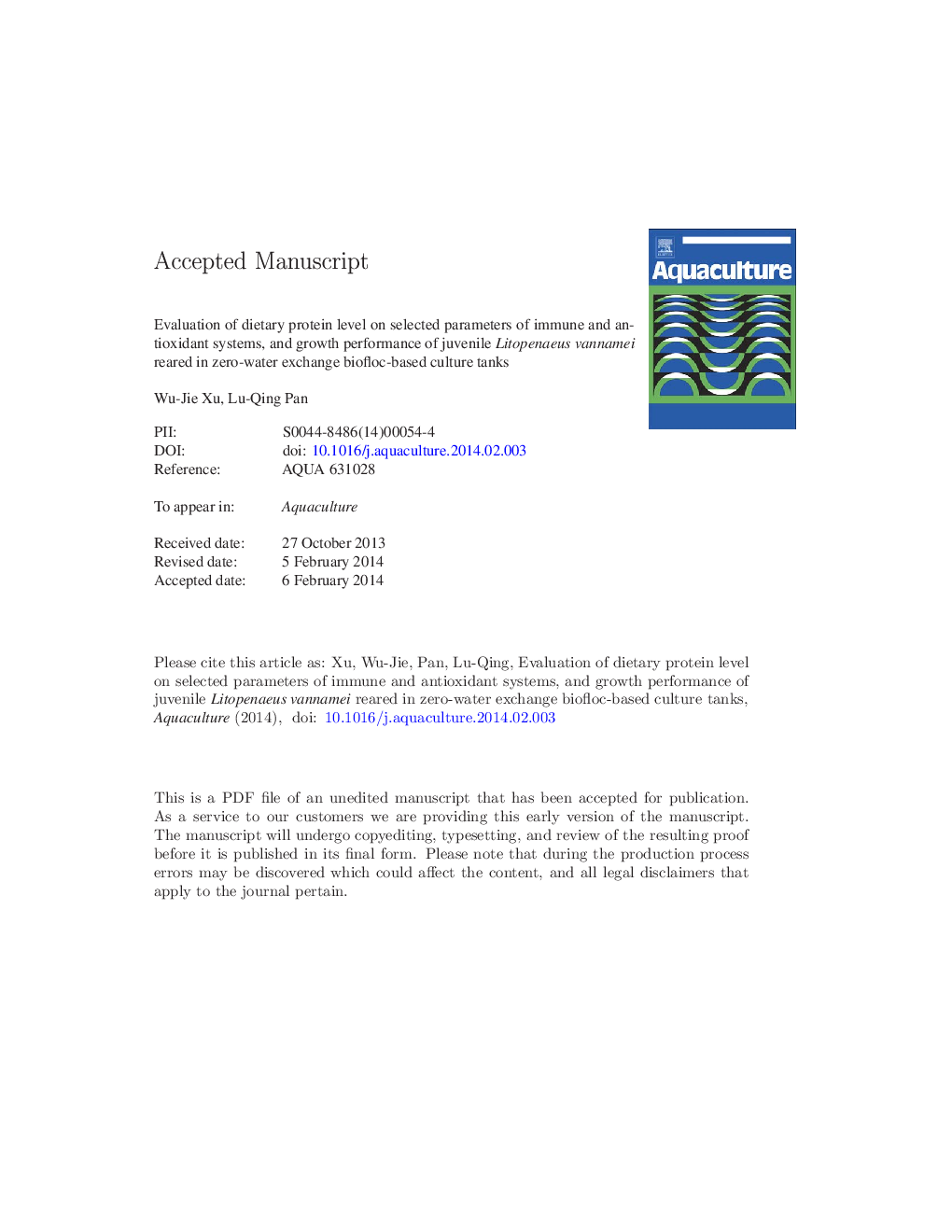| کد مقاله | کد نشریه | سال انتشار | مقاله انگلیسی | نسخه تمام متن |
|---|---|---|---|---|
| 8495151 | 1552859 | 2014 | 38 صفحه PDF | دانلود رایگان |
عنوان انگلیسی مقاله ISI
Evaluation of dietary protein level on selected parameters of immune and antioxidant systems, and growth performance of juvenile Litopenaeus vannamei reared in zero-water exchange biofloc-based culture tanks
دانلود مقاله + سفارش ترجمه
دانلود مقاله ISI انگلیسی
رایگان برای ایرانیان
کلمات کلیدی
موضوعات مرتبط
علوم زیستی و بیوفناوری
علوم کشاورزی و بیولوژیک
علوم آبزیان
پیش نمایش صفحه اول مقاله

چکیده انگلیسی
The biofloc technology was proposed as a sustainable solution to culture shrimp with low protein feeds even in intensive systems, which can effectively control water quality under negligible water exchange and sustain healthy culture of shrimp. This study was conducted to evaluate the effects of four dietary protein levels (20%, 25%, 30% and 35%) on selected parameters of immune and antioxidant systems, and growth performance of Litopenaeus vannamei juveniles reared in zero-water exchange biofloc-based intensive culture tanks for a period of 7Â weeks. Good water quality was maintained with the promotion and development of biofloc through sucrose addition during the feeding experiment. At the end of the experiment, the total hemocyte count in the hemolymph, phagocytic activity of the hemocyte, and antibacterial activity and bacteriolytic activity in the plasma of shrimp showed no significant differences (PÂ >Â 0.05) among the four treatments with four dietary protein levels. The shrimp in the treatment with 20% dietary protein level had the lowest total antioxidant capacity (T-AOC) in both the plasma and the hepatopancreas, and the lowest reduced glutathione/oxidized glutathione (GSH/GSSG) ratio in the plasma. No significant differences were found in the antioxidant status (in terms of T-AOC, superoxide dismutase activity, GSH level and GSH/GSSG ratio in the plasma and the hepatopancreas) of shrimp fed with 25%, 30% and 35% dietary protein levels. Furthermore, except for the suboptimal growth performance of shrimp in the treatment with 20% dietary protein level, the growth (in terms of final weight, weight gain and specific growth rate) and feed conversion rate (FCR) of shrimp in treatments with 25%, 30% and 35% dietary protein levels showed no significant differences (PÂ >Â 0.05). Mean survival rates were above 85%, with no significant differences (PÂ >Â 0.05) among the four treatments with four dietary protein levels. The results of this study demonstrated that, when juveniles of L. vannamei were reared in zero-water exchange biofloc-based intensive culture tanks, dietary protein level can be reduced from 35% to 25% without affecting survival, growth, FCR, and physiological status of immune response and antioxidant capability, indicating that the promoted biofloc could contribute to the protein nutrition and physiological health of cultured shrimp.
ناشر
Database: Elsevier - ScienceDirect (ساینس دایرکت)
Journal: Aquaculture - Volumes 426â427, 20 April 2014, Pages 181-188
Journal: Aquaculture - Volumes 426â427, 20 April 2014, Pages 181-188
نویسندگان
Wu-Jie Xu, Lu-Qing Pan,